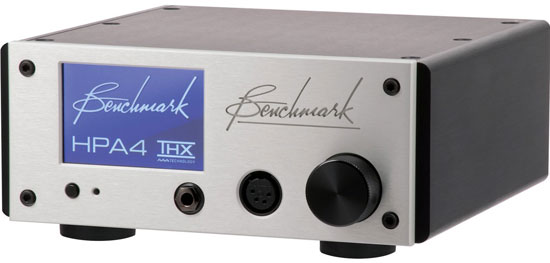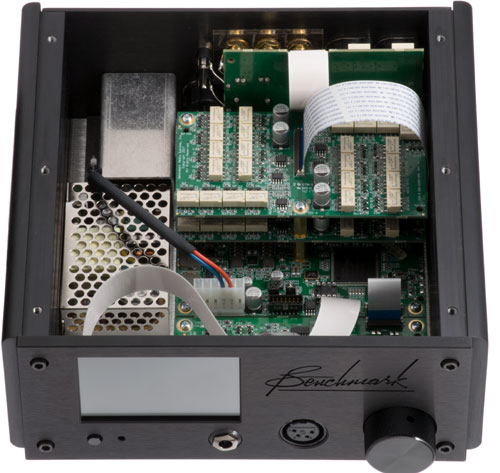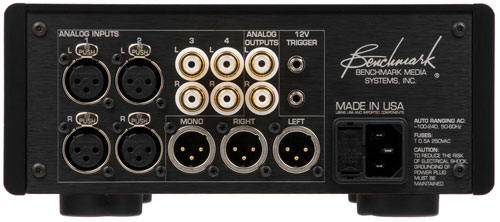
Barry's Mix Magazine Equipment And Software Reviews
Barry's Massive Discography And Engineering Career
Barry's Music Connection Magazine Reviews
Barry's Resolution Magazine Reviews
Benchmark Media Systems HPA4
Headphone/Line Amplifier With Built-in THX-888
By Barry Rudolph
 |
| Benchmark Media Systems HPA4 |
Benchmark Media Systems' HPA4 Headphone Amp incorporates the company's LA4 Line Amplifier into a single, 2U, half-width cabinet. With identical performance and feature sets, the HPA4 enables complete and separate control of both the LA4 Line Amp to drive your main stereo monitor speaker system and the built-in THX-888 amplifier to drive any set of headphones, including difficult-to-drive planar magnetic headphones. THX™ AAA is the same technology used for the company's AHB2 power amplifier.
The HPA4 has four stereo inputs: two pairs of balanced XLRs for up to +24dBu (19.5 Vrms) signals and two pairs of gold-plated, unbalanced RCA jacks that accept up to +12.2 dBu (3.2 Vrms). There are L/R XLR outputs and a set of RCA unbalanced outputs. There is also a summed (L+R) mono output for connection to a separate subwoofer.
The HPA4 is available in a 2U rackmount version and in either silver or black finishes. The clean front panel has a single large volume control that uses an optical encoder to set volume in 256 half-dB steps. Sixty-four precision relays with gold contacts use a stack of precision metal film resistors for a range from +15dB to -122 dB, or mute.
The front panel has an intuitive 3.5-inch color TFT touchscreen to facilitate source input selection and rename and lock/unlock certain settings. There are separate L/R balance and Mute buttons for the line and headphone amp outputs, -20dB Dim, power up/down programming, setting up a pair of 12-volt, bi-directional rear panel ports for sequential power up/down of connected gear.
The volume level for both the line-level and headphone outputs are displayed on separate calibrated vertical bar graphs. Pushing in on the Volume control links/unlinks the headphone and line levels to track together, or not. You may also just touch the bars to do the same thing, although the bars are close together and I sometimes inadvertently select the wrong one, or both at the same time. The front panel has both a conventional TRS jack for headphones plus an XLR4 connector with dedicated pins for the left and right channels. My review unit came with an optional IR remote control that allows control of it, plus any Benchmark Media DAC, from the listening position.
ULTIMATE ANALOG SIGNAL PATH
 |
 |
| Benchmark Media Systems HPA4--Inside and Out |
Designed to be the ultimate analog controller, the HPA4 uses precision differential amplifiers on all inputs to reject common-mode noise and distortion from any source devices without differential output amp stages (most DACs).
The unit is flat from 0.1 Hz to 500 kHz, with accurate phase response in the entire audio band. The signal-to-noise ratio is greater than 135 dB, and the THX-888 headphone output amplifier's total harmonic distortion is less than -125 dB, (0.00006%) under full load, and does not increase with output power--from 6 milliwatts to 6 watts into a 16-ohm load. Most performance specifications are near the measurement limits of the Audio Precision AP2722 test system.
High-impedance headphones require higher voltages, and the HPA4 will deliver 11.9 Vrms into 300 ohms--enough for low-sensitivity phones such as the Audeze $4,000 LCD-4 pair that requires more than 500 mW with an impedance of 200 ohms or the customized $10,000 Abyss AB-1266 Phi TC headphones--both use planar magnetic speaker drivers.
I tested the HPA4 as both a headphone amplifier and as an analog monitor controller to drive my modest Kali IN8 three-way powered monitors, and a pair of PMC twotwo.8s. For consistency, I used my own set of short, Swiss-made VOVOX XLR cables for connection from source outputs and to the input to the monitors.
LISTENING TESTSI listened to mostly my original un-mastered music mixes or songs that were in process, or were done in my studio. I compared the difference in sound quality, detail and overall tonality shift with the same music played using the typical methods used in the studios I visited.
I liked that the unbalanced inputs are automatically boosted by 15.8 dB so when switching between balanced XLR sources and the unbalanced RCA inputs, the volume levels were similar.
Listening on either headphones or monitors, in general there was a remarkable and very "hearable" improvement in quality compared to the usual way I monitor analog sources; it is not subtle.
There is an immediate change in overall clarity, transparency, reduced muddiness, dynamic range and noticeably better reproduction of percussive bass instruments--upright bass, kicks and synth basses. The HPA4 has low frequency extension down to 0.1 Hz with the result that the bass sounds more damped.
Recordings with good dynamic range are reproduced without effort, and even driving my low-gain Kali monitors, the HPA4 made them more powerful-sounding and dynamic. I tried every set of headphones in my collection, including a borrowed pair of Focal Clear Professional with 55-ohm impedance. A change in quality is less noticeable with cheaper phones but the Focal Clear Pros sounded noticeably better.
SO WORTH IT!
Listening on either my monitors or headphones to music I know very well revealed detail, hidden sonic effects and some past questionable mixing decisions! The HPA-4 is the biggest sonic microscope I have ever used. For better or worse, any amount of dynamic alteration (compressing/limiting) or EQ/filtering is immediately heard. I would love to own the HPA4 for the final playback test for every mix I do from now on!.
|
|
|
|
|